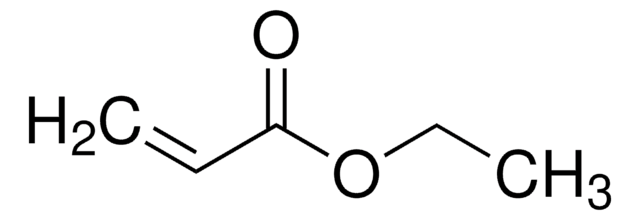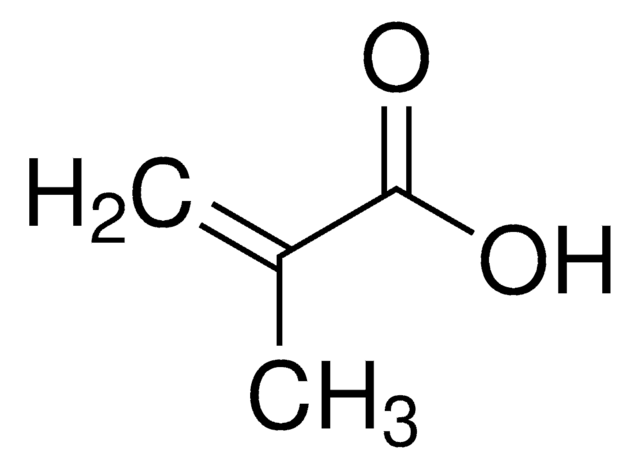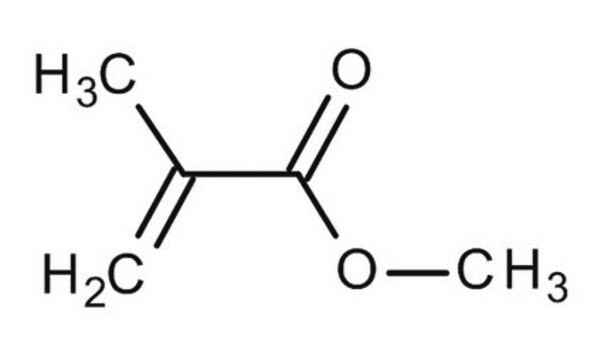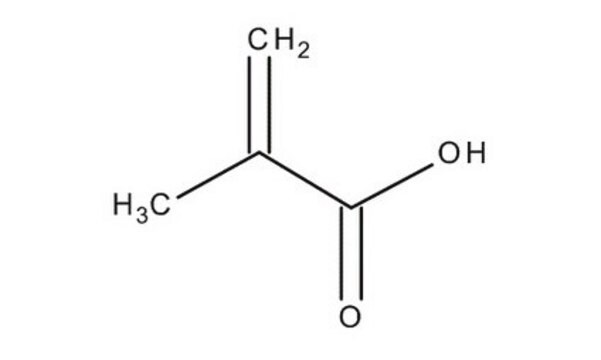W241811
Ethyl acrylate
≥99.5%, stabilized
Sinónimos:
Acrylic acid ethyl ester, Ethyl 2-propenoate
About This Item
Productos recomendados
biological source
synthetic
Quality Level
grade
Kosher
reg. compliance
FDA 21 CFR 117
vapor density
3.5 (vs air)
vapor pressure
31 mmHg ( 20 °C)
assay
≥99.5%
form
liquid
autoignition temp.
721 °F
contains
10-30 ppm MEHQ as stabilizer (synthetic)
expl. lim.
12.1 %
refractive index
n20/D 1.406 (lit.)
bp
99 °C (lit.)
mp
−71 °C (lit.)
density
0.918 g/mL at 25 °C (lit.)
application(s)
flavors and fragrances
documentation
see Safety & Documentation for available documents
food allergen
no known allergens
organoleptic
plastic
SMILES string
CCOC(=O)C=C
InChI
1S/C5H8O2/c1-3-5(6)7-4-2/h3H,1,4H2,2H3
InChI key
JIGUQPWFLRLWPJ-UHFFFAOYSA-N
¿Está buscando productos similares? Visita Guía de comparación de productos
General description
Application
- Refractive index adjustable intraocular lens design to achieve diopter control for improving the treatment of ametropia after cataract surgery.: This study involves the use of ethyl acrylate in developing intraocular lenses with adjustable refractive indices, which aims to improve visual outcomes in patients undergoing cataract surgery by providing customizable diopter control (Hong et al., 2024).
Disclaimer
signalword
Danger
Hazard Classifications
Acute Tox. 3 Inhalation - Acute Tox. 4 Dermal - Acute Tox. 4 Oral - Aquatic Chronic 3 - Eye Irrit. 2 - Flam. Liq. 2 - Skin Irrit. 2 - Skin Sens. 1 - STOT SE 3
target_organs
Respiratory system
Storage Class
3 - Flammable liquids
wgk_germany
WGK 2
flash_point_f
48.2 °F - closed cup
flash_point_c
9 °C - closed cup
Certificados de análisis (COA)
Busque Certificados de análisis (COA) introduciendo el número de lote del producto. Los números de lote se encuentran en la etiqueta del producto después de las palabras «Lot» o «Batch»
¿Ya tiene este producto?
Encuentre la documentación para los productos que ha comprado recientemente en la Biblioteca de documentos.
Los clientes también vieron
Nuestro equipo de científicos tiene experiencia en todas las áreas de investigación: Ciencias de la vida, Ciencia de los materiales, Síntesis química, Cromatografía, Analítica y muchas otras.
Póngase en contacto con el Servicio técnico










